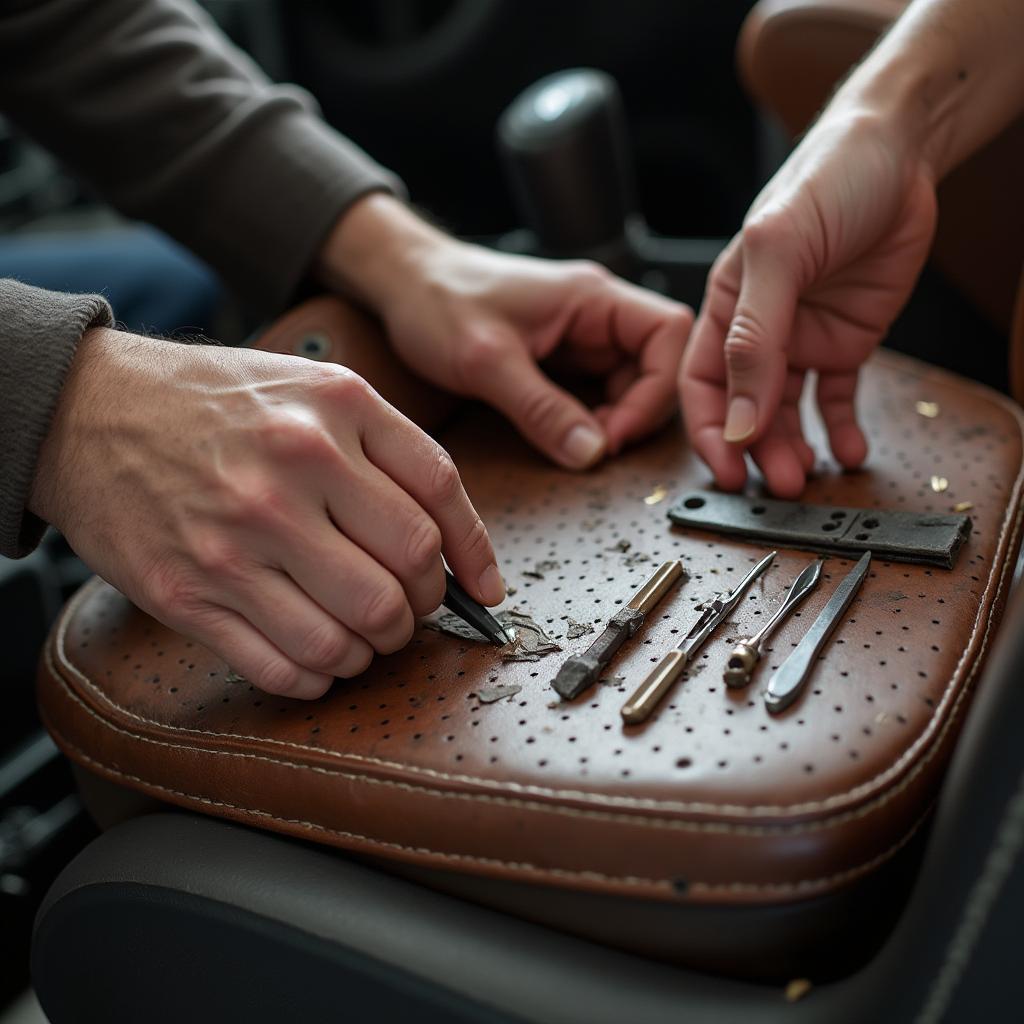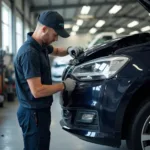Perforated leather car seats can add a touch of luxury and style to any vehicle. However, the delicate nature of perforated leather makes it susceptible to tears, especially with regular wear and tear. Discovering a tear in your pristine seats can be frustrating, but fret not! With the right approach and a bit of patience, you can repair the damage and restore your seats to their former glory. This comprehensive guide will walk you through the steps on how to repair perforated leather car seats tear, providing you with the knowledge and confidence to tackle this DIY project.
Understanding Perforated Leather and Common Causes of Tears
Before diving into the repair process, it’s essential to understand the material you’re dealing with. Perforated leather is created by punching small holes in the leather’s surface, enhancing breathability and comfort. While visually appealing, these perforations can weaken the leather, making it prone to tears, especially along the perforated lines.
Common culprits behind perforated leather car seat tears include:
- Sharp objects: Keys, pens, even sharp edges on clothing can easily puncture and tear the delicate leather.
- Friction and abrasion: Constant rubbing from getting in and out of the car, as well as friction from luggage or pets, can wear down the leather and lead to tears.
- Improper cleaning: Using harsh chemicals or abrasive materials can strip the leather’s natural oils, drying it out and making it susceptible to cracking and tearing.
- Sun damage: Prolonged exposure to UV rays can fade and weaken the leather, increasing the risk of tears.
 A person using a leather repair kit to fix a tear in a perforated leather car seat
A person using a leather repair kit to fix a tear in a perforated leather car seat
Essential Tools and Materials for Repairing Perforated Leather Car Seats
Having the right tools and materials on hand will make the repair process smoother and more effective. Here’s a list of essentials you’ll need:
- Leather repair kit: Opt for a high-quality kit specifically designed for leather repair. These kits typically include a color-matched filler paste, a backing fabric, an application spatula, and a color blending compound.
- Cleaning solution: Choose a pH-neutral leather cleaner to remove dirt, grime, and any residues without damaging the leather. Avoid household cleaners as they can be too harsh for leather.
- Microfiber cloths: Use soft, lint-free microfiber cloths for cleaning and applying the repair products.
- Scissors: Sharp scissors will be needed to cut the backing fabric and any excess repair material.
- Rubbing alcohol: This will be used to clean the area around the tear and ensure proper adhesion of the repair materials.
- Hairdryer (optional): A hairdryer can speed up the drying process of the filler paste.
- Leather conditioner: Once the repair is complete, you’ll need a good quality leather conditioner to rehydrate and protect the leather.
“When choosing a leather repair kit, it’s crucial to select a color that closely matches your car’s interior. A slight variation in shade is acceptable, as you can blend the color later for a seamless finish.” – Johnathan Miller, Senior Automotive Leather Technician.
Step-by-Step Guide to Repairing a Tear in Perforated Leather Car Seat
Now that you have your tools and materials ready, follow these steps to repair the tear in your perforated leather car seat:
1. Clean the Area:
Begin by cleaning the damaged area thoroughly. Apply a small amount of leather cleaner to a microfiber cloth and gently wipe the surface. Ensure you clean around the perforations, removing any dirt or debris trapped within.
2. Prepare the Tear:
Inspect the tear closely and trim any loose threads or frayed edges using sharp scissors. Be careful not to enlarge the tear during this process.
3. Apply Backing Fabric (If Necessary):
For larger tears or holes, you’ll need to provide additional support with a backing fabric. Cut a piece of backing fabric slightly larger than the tear. Apply a thin layer of leather adhesive to the back of the tear and carefully place the backing fabric over it, smoothing out any wrinkles.
4. Fill the Tear with Leather Filler:
Using the application spatula from your leather repair kit, carefully fill the tear with the leather filler paste. Overfill the tear slightly to account for shrinkage during the drying process.
5. Smooth and Blend the Filler:
Gently smooth the surface of the filler paste with the spatula, ensuring it’s level with the surrounding leather. If necessary, you can use a damp microfiber cloth to further blend the edges.
6. Dry and Repeat (If Needed):
Allow the filler paste to dry completely. You can use a hairdryer on a low setting to speed up the drying process. Once dry, inspect the area and repeat steps 4 and 5 if necessary to achieve a smooth and even surface.
7. Apply Color Blending Compound (If Needed):
If there’s a slight color mismatch between the filler paste and your leather, use the color blending compound from your repair kit. Apply a small amount to a clean microfiber cloth and gently rub it onto the repaired area in a circular motion, gradually blending the color until it matches seamlessly.
8. Condition the Leather:
Once the repair is completely dry, apply a high-quality leather conditioner to the entire seat. This will help to rehydrate the leather, protect it from future damage, and restore its natural shine.
Maintaining Your Repaired Perforated Leather Car Seats
Prevention is key to maintaining the beauty and longevity of your newly repaired perforated leather car seats. Follow these simple tips to keep your seats looking their best:
- Regular cleaning: Wipe down your seats weekly with a damp microfiber cloth to remove dust and dirt.
- Use a leather conditioner: Apply a leather conditioner every few months to keep the leather hydrated and prevent cracking.
- Avoid sharp objects: Be mindful of sharp objects that could potentially damage your seats.
- Protect from sun damage: Park your car in the shade whenever possible or use a sunshade to protect the interior from harmful UV rays.
Frequently Asked Questions (FAQ)
Q: Can I repair a tear in my perforated leather car seat myself?
A: Absolutely! With the right tools and a little patience, repairing minor tears in perforated leather car seats is a manageable DIY project.
Q: What’s the best way to clean perforated leather car seats?
A: Use a pH-neutral leather cleaner and a soft microfiber cloth. Avoid harsh chemicals or abrasive materials.
Q: How can I prevent tears in my perforated leather car seats?
A: Be mindful of sharp objects, use a leather conditioner regularly, and protect your seats from sun damage.
Q: Can I use a regular leather repair kit on perforated leather?
A: While some regular kits might work, it’s best to opt for a kit specifically designed for perforated leather to ensure optimal results.
Q: How long will the repair last?
A: With proper care and maintenance, a well-executed repair can last for a long time.
Conclusion
Repairing a tear in your perforated leather car seats doesn’t have to be a daunting task. By following the step-by-step guide outlined in this article, you can restore your seats’ appearance and enjoy that luxurious feel for years to come. Remember, patience and attention to detail are key to achieving a seamless repair. However, if you’re dealing with extensive damage or are unsure about any part of the process, it’s always best to consult a professional automotive upholstery specialist.
Need further assistance with your car repair needs? Don’t hesitate to reach out to our expert team via WhatsApp: +1(641)206-8880 or Email: [email protected]. We offer 24/7 customer support to address all your inquiries.


